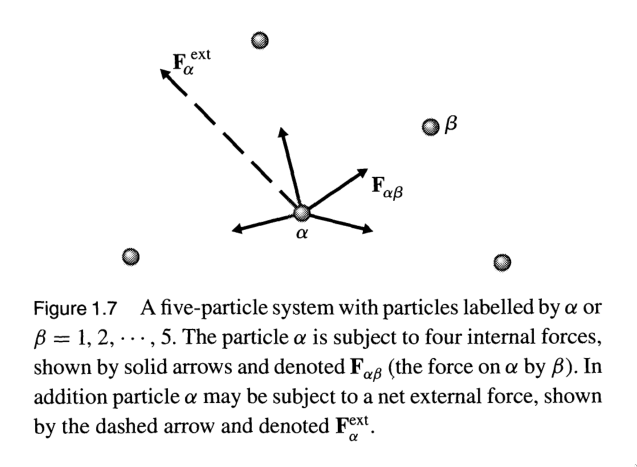This is a multiparticle system proposed in the taylor's classical mechanics textbook (pg 20-21) :

The derivation of the rate of change of total momentum is given as follows:
$$ \begin{aligned} \text{net force on particle} \ \alpha = F_{\alpha} &= \sum_{\beta \neq \alpha} F_{\alpha\beta} + F_{\alpha}^{ext} \\ \dot{p_\alpha} &= \sum_{\beta \neq \alpha} F_{\alpha\beta} + F_{\alpha}^{ext} \\ \text{total momentum of the system} = P &= \sum_{\alpha} p_\alpha \\ \dot{P} &= \sum_{\alpha} \dot{p_\alpha} \\ &= \sum_\alpha \sum_{\beta \neq \alpha} F_{\alpha\beta} + \sum_{\alpha}F_\alpha^{ext} \end{aligned} $$
The double sum here contains $N(N-1)$ terms in all. Each term $F_{\alpha\beta}$ in this sum can be paired with a second term $F_{\beta \alpha}$, so that
$$ \sum_{\alpha} \sum_{\beta \neq \alpha} F_{\alpha\beta} = \sum_\alpha \sum_{\beta > \alpha} (F_{\alpha\beta} + F_{\beta \alpha}) $$
Then it mentions that by third law the sum of action-reaction forces is zero (which makes sense), therefore the double sum is zero, we conclude that
$$ \dot{P} = \sum_{\alpha} F_{\alpha}^{ext} = F^{ext} $$
The things that doesn't make sense to me are:
- Why do we only consider the momentum of $\alpha$ in the total momentum of the system? (or are there assumptions being made?)
- What does the $N(N-1)$ part means? (the whole quoted sentence) How does it lead to the equation at its next line(the double summation)?
